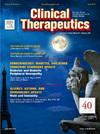Weight Loss With Once-nightly Sodium Oxybate for the Treatment of Narcolepsy: Analysis From the Phase III Randomized study Evaluating the efficacy and SafeTy of a ONce nightly formulation of sodium oxybate (REST-ON) Trial
IF 3.2
4区 医学
Q2 PHARMACOLOGY & PHARMACY
引用次数: 0
Abstract
Purpose
Individuals with narcolepsy are more likely to be obese than the general population. Changes in weight-related measures with extended-release, once-nightly sodium oxybate (ON-SXB) and characteristics of participants with ≥5% weight loss were assessed in a Randomized study Evaluating the efficacy and SafeTy of a ONce nightly formulation of sodium oxybate (REST-ON) trial post hoc analysis.
Methods
REST-ON (NCT02720744) was a Phase III, double-blind, placebo-controlled, multicenter, randomized clinical trial. Participants aged ≥16 years with narcolepsy type 1 (NT1) or NT2 received ON-SXB or placebo for 13 weeks (week 1, 4.5 g; weeks 2–3, 6 g; weeks 4–8, 7.5 g; and weeks 9–13, 9 g). Weight and body mass index were measured at baseline and study end.
Findings
Weights were similar between groups at baseline (mean [SD]; ON-SXB, 81.2 [20.8] kg; N = 107 [NT1, n = 80; NT2, n = 27]; placebo, 82.1 [22.5] kg; N = 105 [NT1, n = 82; NT2, n = 23]). At week 13 (9 g), mean (SD) weight decreased 1.3 (3.6) kg with ON-SXB and increased 0.2 (2.6) kg with placebo; 17.8% (19/107; NT1, n = 14; NT2, n = 5) of participants receiving ON-SXB had ≥5% weight loss versus 3.8% receiving placebo (4/105; NT1, n = 3; NT2, n = 1; P = 0.001). At week 13, least squares mean (SE) body mass index change from baseline was ‒0.51 (0.13) kg/m2 with ON-SXB and 0.08 (0.13) kg/m2 with placebo (least squares mean difference [95% CI], −0.59 [−0.95 to −0.23] kg/m2; P = 0.001). Excessive daytime sleepiness improved for both groups with ON-SXB, the ≥5% weight-loss subgroup exhibited larger improvement in the Maintenance of Wakefulness Test and Epworth Sleepiness Scale versus the other subgroup (weight loss <5%, no change, or weight gain) (Maintenance of Wakefulness Test, P = 0.019; Epworth Sleepiness Scale score, P < 0.001).
Implications
Narcolepsy is often associated with obesity, which may increase cardiometabolic risks. ON-SXB, an effective treatment for excessive daytime sleepiness and cataplexy, may be preferred in overweight or obese individuals to provide a more tailored treatment approach.
ClinicalTrials.gov identifier
NCT02720744.
每晚一次的羟苯磺酸钠治疗嗜睡症可减轻体重:每晚一次羟苯甲酸钠制剂的疗效和安全性评估 III 期随机研究(REST-ON)试验分析》。
目的:与普通人相比,嗜睡症患者更容易肥胖。在一项 "每晚服用一次羟苯甲酸钠制剂的疗效和安全性随机研究"(REST-ON)试验的事后分析中,评估了使用缓释、每晚一次的羟苯甲酸钠(ON-SXB)后体重相关指标的变化以及体重减轻≥5%的参与者的特征:REST-ON(NCT02720744)是一项III期、双盲、安慰剂对照、多中心、随机临床试验。年龄≥16岁的嗜睡症1型(NT1)或NT2患者接受了为期13周的ON-SXB或安慰剂治疗(第1周,4.5克;第2-3周,6克;第4-8周,7.5克;第9-13周,9克)。在基线和研究结束时测量体重和体重指数:各组基线体重相似(平均值 [SD]; ON-SXB,81.2 [20.8] kg; N = 107 [NT1,n = 80; NT2,n = 27];安慰剂,82.1 [22.5] kg; N = 105 [NT1,n = 82; NT2,n = 23])。第13周(9克)时,服用ON-SXB的参与者体重平均(标度)下降1.3(3.6)千克,服用安慰剂的参与者体重增加0.2(2.6)千克;服用ON-SXB的参与者中有17.8%(19/107;NT1,n = 14;NT2,n = 5)体重下降≥5%,而服用安慰剂的参与者中有3.8%(4/105;NT1,n = 3;NT2,n = 1;P = 0.001)体重下降≥5%。第 13 周时,ON-SXB 与基线相比的体重指数最小平方均值(SE)变化为 -0.51 (0.13) kg/m2,安慰剂为 0.08 (0.13) kg/m2(最小平方均值差异 [95%CI],-0.59 [-0.95 至 -0.23] kg/m2;P = 0.001)。使用ON-SXB后,两组患者白天过度嗜睡的情况都有所改善,体重减轻≥5%的亚组在保持清醒测试和埃普沃思嗜睡量表方面的改善幅度大于其他亚组(体重减轻影响):嗜睡症通常与肥胖有关,而肥胖可能会增加心脏代谢风险。ON-SXB是一种治疗白天嗜睡过度和惊厥的有效方法,超重或肥胖者可能会首选ON-SXB,以提供更有针对性的治疗方法:Gov 标识符:NCT02720744。
本文章由计算机程序翻译,如有差异,请以英文原文为准。
求助全文
约1分钟内获得全文
求助全文
来源期刊

Clinical therapeutics
医学-药学
CiteScore
6.00
自引率
3.10%
发文量
154
审稿时长
9 weeks
期刊介绍:
Clinical Therapeutics provides peer-reviewed, rapid publication of recent developments in drug and other therapies as well as in diagnostics, pharmacoeconomics, health policy, treatment outcomes, and innovations in drug and biologics research. In addition Clinical Therapeutics features updates on specific topics collated by expert Topic Editors. Clinical Therapeutics is read by a large international audience of scientists and clinicians in a variety of research, academic, and clinical practice settings. Articles are indexed by all major biomedical abstracting databases.
 求助内容:
求助内容: 应助结果提醒方式:
应助结果提醒方式:


